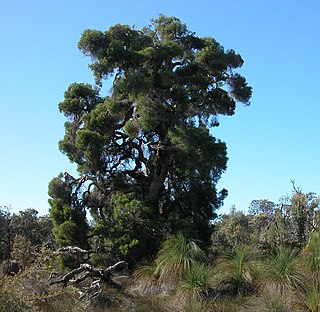
Melaleuca preissiana, commonly known as stout paperbark, modong or moonah, is a plant in the myrtle family, Myrtaceae and is endemic to coastal areas of southwest Australia. It is a shrub or small tree with papery bark, small leaves and spikes of usually white flowers. It occurs chiefly in areas that are seasonally wet.
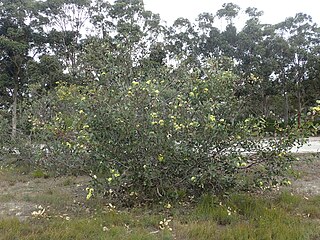
Eucalyptus preissiana, commonly known as bell-fruited mallee, is a species of small tree or shrub that occurs in an area between Albany and Esperance in Western Australia. It has a spreading habit, smooth bark, elliptical to egg-shaped or oblong leaves, flower buds in groups of three, yellow flowers and cup-shaped, conical or bell-shaped fruit.
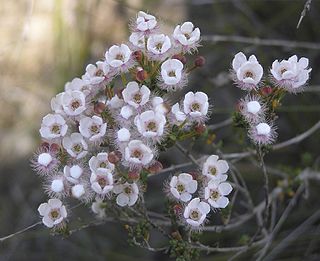
Verticordia habrantha, commonly known as hidden featherflower, is a flowering plant in the myrtle family, Myrtaceae and is endemic to the south-west of Western Australia. It is a slender shrub with short, leafy side-branches and long flowering stems with rounded heads of mostly white flowers. Its hairy sepals are mostly hidden by the round, unfringed petals, and as a result, the plant looks like shrubs in the genus Chamelaucium, to which it is closely related.

Kunzea baxteri, commonly known as scarlet kunzea, is a flowering plant in the myrtle family, Myrtaceae and is endemic to the south-west of Western Australia where it occurs near granite outcrops and hills. It is a shrub with large, scarlet, bottlebrush-like flower clusters, making it popular as a garden feature.
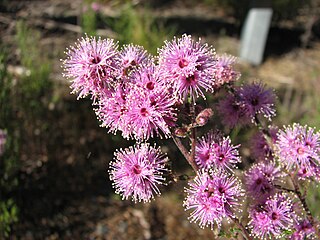
Kunzea parvifolia, commonly known as the violet kunzea, is a flowering plant in the myrtle family, Myrtaceae and is endemic to eastern Australia. It is a wiry shrub with small, narrow leaves and clusters of pink to purple flowers in spring.

Melaleuca aspalathoides is a small shrub in the myrtle family, Myrtaceae and is endemic to a small area in the south-west of Western Australia. It is a small shrub with soft, grey foliage and distinctive calyx lobes around each of its magenta-coloured flowers.

Melaleuca violacea is a plant in the myrtle family Myrtaceae and is endemic to a small area in the south-west of Western Australia. It is a small, straggly, prostrate to semi-prostrate shrub with purple flowers and star-shaped fruit.
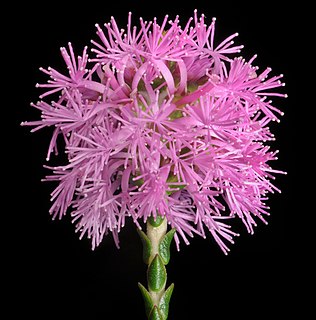
Regelia inops is a plant in the myrtle family, Myrtaceae and is endemic to the south-west of Western Australia. It is an upright but often spreading shrub with tiny wedge shaped leaves and small heads of pink flowers on the ends of its branches in the warmer months.
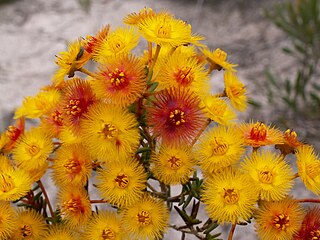
Verticordia endlicheriana is a flowering plant in the myrtle family, Myrtaceae and is endemic to the south-west of Western Australia. It is a shrub with narrow leaves and yellow flowers which in some varieties age to red. It is a variable species and in his 1991 paper, Alex George formally described five varieties.
Verticordia lehmannii is a flowering plant in the myrtle family, Myrtaceae and is endemic to the south-west of Western Australia. It is slender shrub with only a few branches, well-spaced, oppositely arranged leaves and small heads of pale pink to silvery flowers with a dark pink centre.
Kunzea affinis is a flowering plant in the myrtle family, Myrtaceae and is endemic to the south-west of Western Australia. It is a shrub with many branches, small, crowded leaves and pink, five-petalled flowers in early spring.

Kunzea micrantha is a flowering plant in the myrtle family, Myrtaceae and is endemic to the south west of Western Australia. It blooms between September and December producing pink-purple to white-cream flowers. A widespread and variable species, it is difficult to distinguish from K. praestans and from K. micromera where their range overlap.

Kunzea micromera is a flowering plant in the myrtle family, Myrtaceae and is endemic to the south west of Western Australia. It is a small, sparse shrub, similar in some respects to K. micrantha but has shorter, more rounded sepal lobes. It produces groups of pink flowers on the ends of a few long shoots in spring.

Kunzea similis is a species of flowering plant in the myrtle family, Myrtaceae and is endemic to a small area along the south coast of Western Australia. It is a shrub with linear to lance-shaped leaves with a single vein, and spherical groups of between four and ten pink flowers on the ends of shoots.
Kunzea praestans is a flowering plant in the myrtle family, Myrtaceae and is endemic to Western Australia. It is an erect shrub with sessile leaves and groups of about fourteen to twenty pink flowers in more or less spherical groups on the end of the branches.
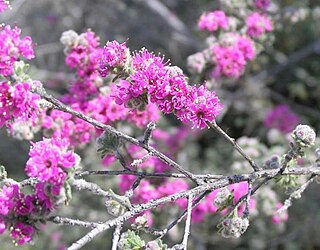
Kunzea preissiana is a flowering plant in the myrtle family, Myrtaceae, and is endemic to the southwest of Western Australia. It is a shrub with hairy branches and leaves, pink to mauve flowers in groups on the ends of shoots, and twenty to thirty stamens about the same length as the petals. It is a widespread, often locally common species across its range.
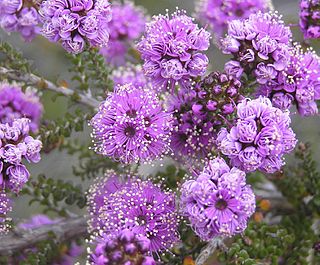
Kunzea recurva is a flowering plant in the myrtle family, Myrtaceae and is endemic to Western Australia. It is an uncommon shrub with small leaves and groups of pink or purplish flowers on the ends of the branches.
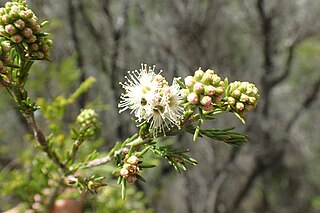
Kunzea spathulata is a species of flowering plant in the myrtle family, Myrtaceae and is endemic to a small area in the south west of Western Australia. It is a tall shrub with erect, much-branched stems, linear leaves and more or less spherical groups of yellow or yellowish green flowers.
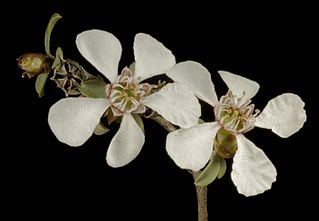
Leptospermum erubescens, commonly known as the roadside tea tree, is a species of shrub that is endemic to southwest of Western Australia. It has thin, fibrous bark, egg-shaped leaves, small white flowers and woody fruit.

Leptospermum glaucescens, commonly known as the blue-green tea tree or smoky tea tree, is a species of shrub or small tree that is endemic to Tasmania. It has elliptical to egg-shaped leaves that are often greyish green, white flowers about 15 mm (0.59 in) in diameter arranged in consecutive leaf axils and fruit that remain on the plant for some time after maturity.


















